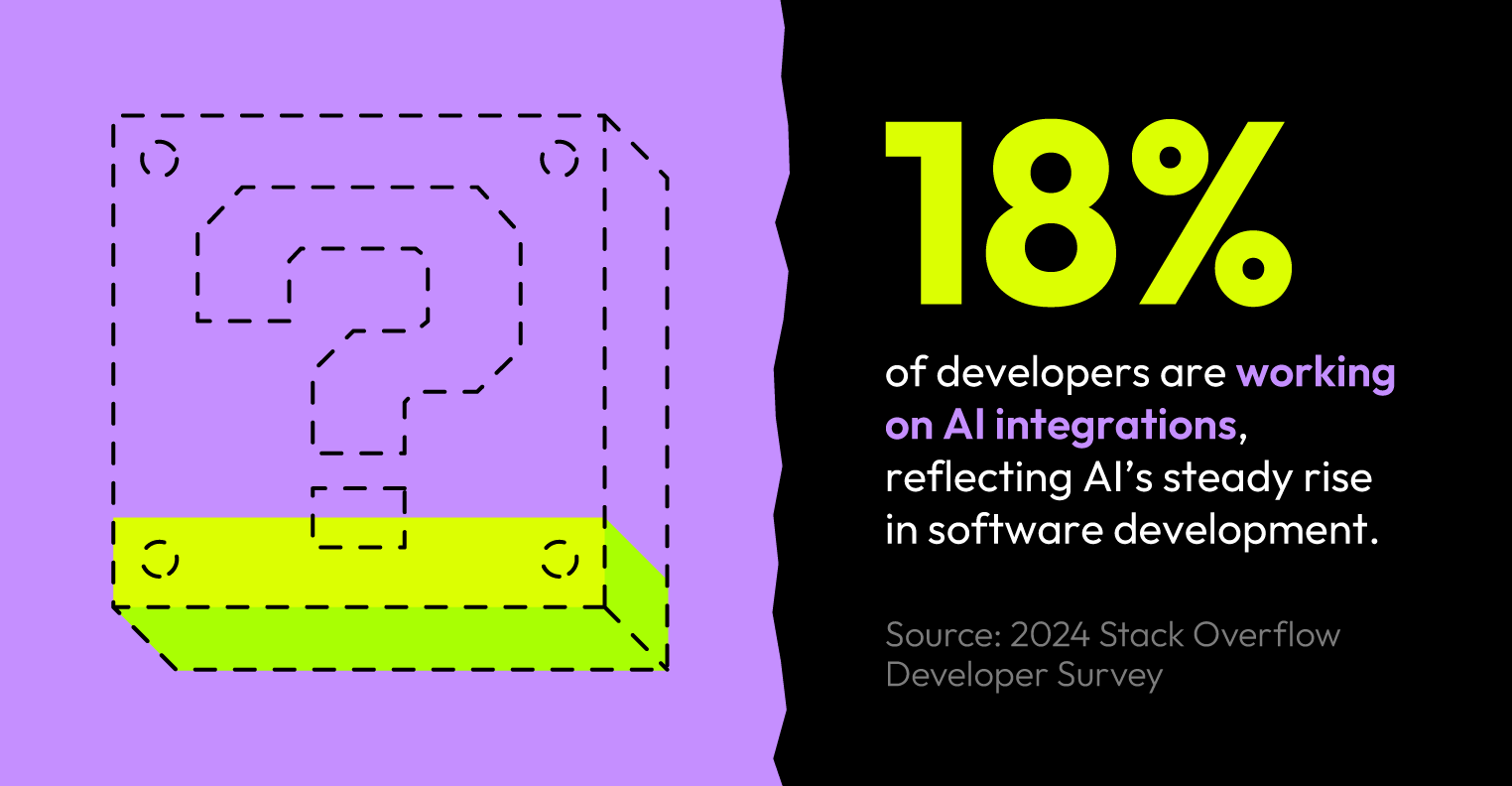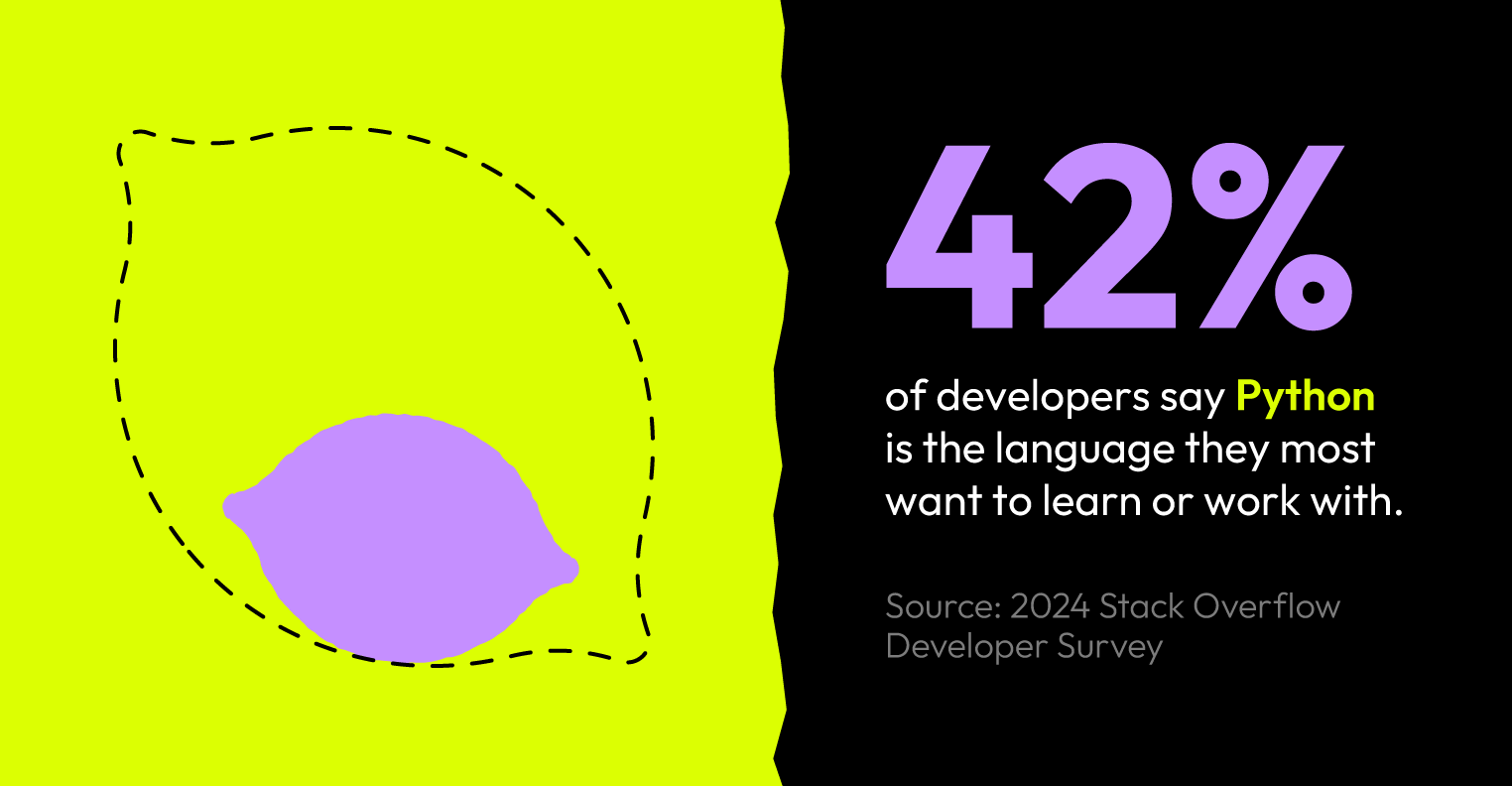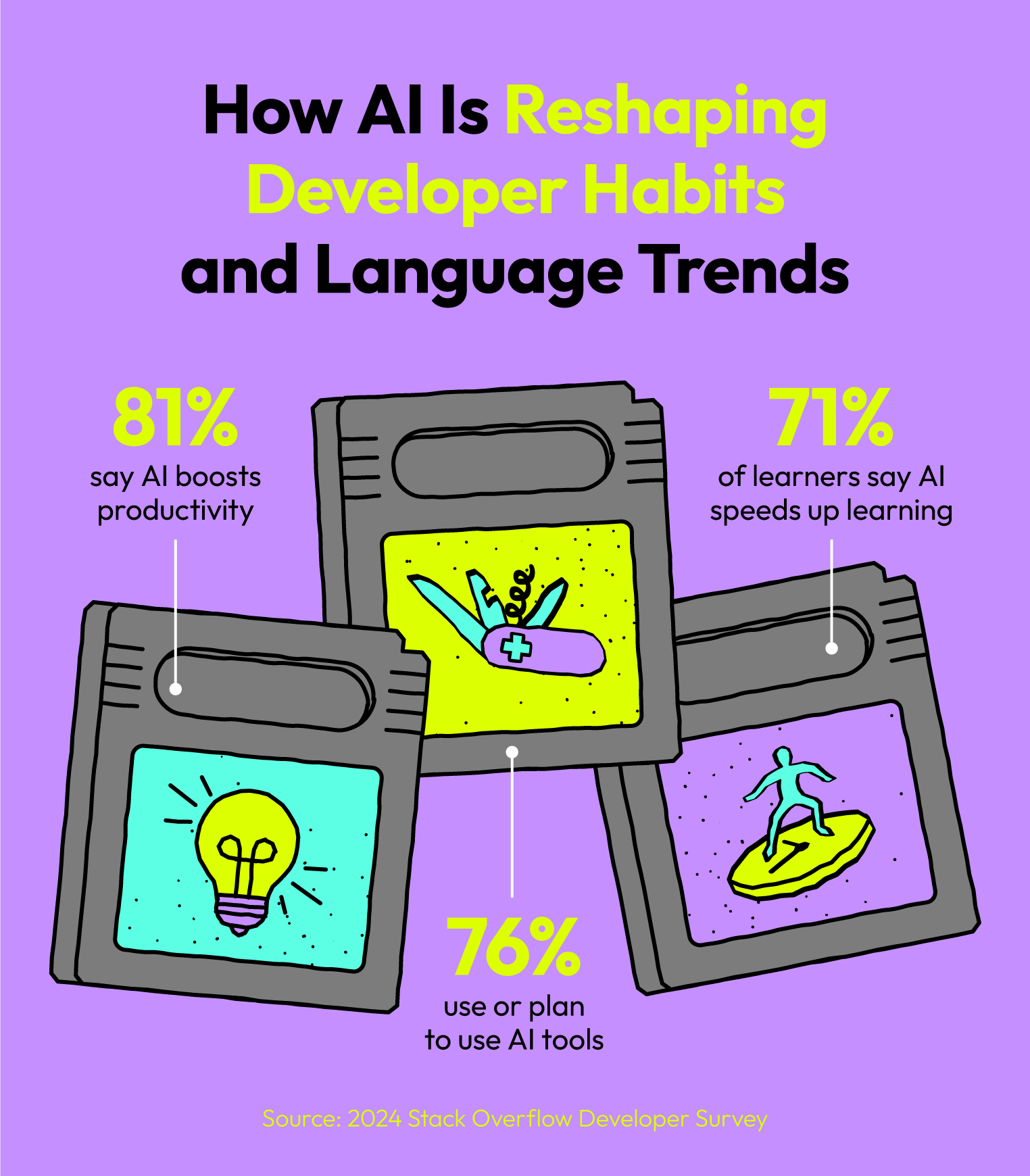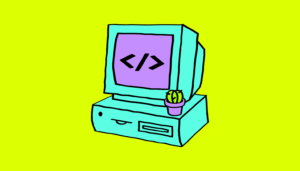Quick Answer:
The most popular programming languages in 2025 are Python, Java, and JavaScript—widely used across web development, data science, and enterprise applications.
In 2025, programming language trends are influencing how startups hire, which tech stacks teams choose, and how fast products ship.
Some languages are surging thanks to AI and data demands. Others are holding strong due to reliability, ecosystem, or community support.
For founders and engineering leads, knowing which languages are most in demand can help you make smarter hiring and software development decisions.
Let’s break down the most in-demand programming languages of 2025 based on real usage data, developer preferences, and job market trends.
Key trends in programming languages for 2025
- Python topped the TIOBE Index in June with a 25.87% share, marking a gain of more than 10% month-over-month.3
- AI tools are influencing language choices, with 76% of developers now using or planning to use them.1
- The software development job market is projected to grow 17.9% from 2023 to 2033.5
1. Python
Python continues to lead the pack in 2025, and its momentum isn’t slowing down.
It recently overtook JavaScript as the most used language on GitHub, driven by rising demand in AI, data science, and backend development. Python also topped the TIOBE Index in June with a 25.87% share, marking a gain of more than 10% MoM.3
That momentum lines up with developer interest. In Stack Overflow’s 2024 survey, Python ranked as the most desired language, with 41.9% of respondents saying they want to learn or work with it.1
On the hiring side, Lemon.io data shows that 5.2% of backend job postings specifically call out Python experience, making it one of the most requested skills for backend roles.4
If you’re aiming for a high-paying software engineering job, Python remains one of the most strategic languages to learn.
Most common uses: AI, machine learning, data science, and automation

2. Java
Java is popular in industries that commonly prioritize performance and stability, like enterprise stacks, large-scale backend systems, and Android development.
Thirty percent of professional developers report using Java, and 39.5% of developers learning to code say they’ve worked with it.1 It also holds the #3 spot on the TIOBE Index, with an 8.84% share and steady YoY.3
Developer sentiment is mixed. While 47.6% admire Java, only 17.9% say they want to work with it.1 A gap this large reflects a broader trend: newer developers are increasingly drawn to more modern or specialized coding languages, especially those with stronger AI support.
Even so, Java continues to deliver where it counts. For teams maintaining mature systems or building at scale, it offers the kind of stability and institutional support that few alternatives can match.
Most common uses: Enterprise software industry, backend systems, and Android development
3. JavaScript
JavaScript remains one of the most widely used programming languages, continuing to play a central role in both frontend and full-stack development in 2025.
In 2024, 64.6% of professional developers reported using JavaScript extensively, and 62.3% said they’ve used it in the past year.1 Its dominance also shows in the npm ecosystem, where JavaScript package consumption grew by 15% YoY.2
That growth is fueled by accessibility. JavaScript is widely taught in boot camps and computer science programs, making it a go-to language for new developers entering the field.2
While Python recently overtook it on GitHub, JavaScript’s staying power is clear. Its adaptability across browsers, frameworks, and runtime environments ensures it continues to thrive across both startup and enterprise teams.
Most common uses: Web development and full-stack applications
4. SQL
SQL (Structured Query Language) remains foundational to modern software stacks in 2025, especially in data-driven roles across engineering and analytics teams.
Despite being more than four decades old, it continues to see broad adoption. Survey data reports that 54% of professional developers report using SQL, as well as 38% of developers learning to code.1
SQL is relatively easy to learn, widely supported across database systems, and essential for working with structured data. Because of this, its longevity comes down to practicality.
That said, SQL did slip to #12 on the TIOBE Index this year, its lowest rank in the index’s history.3 While this may signal a shift in how developers perceive it, SQL’s role in powering data infrastructure hasn’t changed.
As trends in software development continue to evolve, SQL remains a must-have skill for teams managing complex data pipelines or building analytics tools.
Most common uses: Querying databases, analytics, reporting, and data integration

5. C
Few programming languages have shaped computing as deeply as C. More than 50 years after its creation, it still powers the foundations of modern operating systems, embedded devices, and performance-critical software.
16.9% of professional developers report using C, and a surprising 38% of developers learning to code say they’ve worked with it.1 That may reflect its continued presence in computer science curricula and low-level systems training.
C also holds a strong position on the TIOBE Index, accounting for 9.47% of usage, putting it ahead of many newer alternatives.3 However, Shell overtook C in 2024 for the first time, signaling a gradual shift in how developers approach scripting and systems tasks.2
Developer sentiment is also split. 47.4% admire C, but only 13.9% say they want to work with it—a wide gap that suggests developers respect its influence but often prefer more modern tools in practice.
Newer languages like Rust are gaining traction, but C remains deeply embedded in the infrastructure of modern computing. For certain workloads, it’s still the standard.
Most common uses: Systems programming, embedded software, operating systems, and compilers
6. C++
C++ continues to play a vital role in software development, especially in environments where speed and control are non-negotiable.
Survey data reports 53.1% of developers admire C++, but only 18.3% say they want to work with it.1 That gap highlights the tradeoff between its power and its complexity. Developers respect what it can do, but many prefer simpler alternatives in daily use.
C++ holds a strong position in both professional and educational settings, with 20.3% of developers using it on the job and 39.3% of learners having experience with it.1 It also claims a 10.68% share on the TIOBE Index as of June 2025, keeping it firmly in the top tier.3
As software market trends lean toward safer, more modern languages like Rust, C++ still dominates in sectors where performance and control matter most.
Most common uses: Performance-critical applications, game development, embedded systems, and real-time software
7. C#
C# doesn’t always get the spotlight, but it remains one of the most admired languages in the industry. In Stack Overflow’s 2024 survey, 64.1% of developers admire C#, though only 21.6% say they want to work with it, hinting at a gap between perception and daily use.1
Usage remains strong across both professional and beginner audiences, with 28.8% of professional developers report using C#, and 22.5% of those learning to code say they’ve worked with it.1 On the TIOBE Index, C# holds a 4.69% share, keeping it firmly within the top ten languages.3
Much of C#’s staying power comes from its versatility. It is a popular choice for building Windows applications and developing enterprise tools within the .NET ecosystem.
Most common uses: Desktop applications, game development, enterprise software, and web services
8. Rust
Known for its memory safety, performance, and modern syntax, Rust is increasingly being used as a safer alternative to C and C++ in performance-critical applications.2
2024 survey data reveals 82.2% of developers admire Rust, and 28.7% say they want to work with it.¹ Among those who already use it, 83% say they want to continue using it, making Rust the most admired language overall.1
Rust’s footprint is still smaller than legacy languages, but developer enthusiasm continues to grow as more teams explore its use in infrastructure, embedded systems, and blockchain development.
Most common uses: Systems programming, web assembly, blockchain infrastructure, and high-performance applications
How AI and Tools Are Changing Language Preferences
AI tools are no longer on the sidelines.
Developers now use them to write code, review pull requests, generate test cases, and automate repetitive tasks.
That shift is starting to influence which languages developers choose to learn. Ecosystems with strong AI support, like Python and JavaScript, are gaining momentum, while others risk falling behind.
Recent adoption trends include:
- 82% of AI users rely on these tools for code generation.1
- 81% say increased productivity is the top benefit.1
- 76% of developers are using or planning to use AI tools this year, up from 70% in 2023.1
- 71% of developers learning to code say AI helps them learn faster, compared to 61% of professionals.1
- GitHub saw a 98% YoY increase in public generative AI projects, totaling more than 137,000 in 2024.2
- 7.2% of open roles now focus on AI, including machine learning and large language model development.4
As AI-assisted coding becomes more common, developers may favor languages that work seamlessly with these tools. That shift could shape hiring decisions and influence which tech stacks teams invest in next.

Most Unpopular Programming Languages
Developer sentiment not only reveals which languages are trending, but also which ones developers actively avoid.
Zephyr ranked as the least desired language overall, with just 0.4% of respondents saying they want to learn or work with it.1 Despite that, it had the highest admiration score on the list at 54%, suggesting niche interest but very limited practical adoption.
Other low-desire languages include:
- Crystal, Apex, COBOL, and Prolog each drew only 0.7% desire among survey respondents.1
- COBOL’s admiration rate was just 26%, reinforcing its legacy status.
- Prolog and Apex had slightly higher admiration scores (24% and 43%), but still sit far outside modern usage trends.
In most cases, low desire combined with low admiration signals limited long-term viability. For companies still reliant on older languages like COBOL, this can pose a growing talent risk as fewer developers choose to specialize in them.
Programming Language Trends and Salaries
The software development job market is growing fast. The U.S. Bureau of Labor Statistics projects a 18% increase in employment for software developers, QA analysts, and testers from 2023 to 2033, adding more than 300,000 jobs.5
With that growth comes more competition and variation in pay. While popular languages like Python and JavaScript dominate usage, some lesser-known options command much higher salaries1:
- Top earners used Erlang, Elixir, and Clojure, with salaries above $95,000
- Lowest earners used PHP, Dart, and Prolog, averaging under $50,000
- Experience mattered, with higher-paid developers typically having 10+ years in the field
Salary gaps offer valuable insight into how seniority, specialization, and market demand shape earning potential. For developers eyeing the highest-paying software engineering jobs, language choice can be a smart way to differentiate.

Build a Better Engineering Team With Lemon.io
Staying competitive means knowing which tools and technologies are worth investing in—and which skills your team needs to scale. The most popular programming languages in 2025 reflect where the industry is heading, from AI and automation to full-stack development.
Lemon.io connects you with vetted talent so you can hire software developers who already know the tools that matter most.
Build a backend, frontend, or AI-focused team that moves faster, ships smarter, and scales confidently.
Popular Programming Languages FAQ
Is Programming Still Worth Learning In 2025?
Yes, programming skills continue to open doors across tech, finance, healthcare, and beyond, making it one of the most versatile career paths in a digital-first economy.
Which Programming Language Will Be In Demand In 2030?
Languages with strong support, like Python, JavaScript, and TypeScript, are likely to remain in demand as teams prioritize flexibility, speed, and AI integration.
Is Python Still Relevant In 2025?
Python continues to lead in usage and hiring demand, especially for backend development, machine learning, and data science.
Resources
- Stack Overflow (2024) 2024 Developer Survey. Stack Overflow. https://survey.stackoverflow.co/2024/.
- GitHub (2024) The State of Open Source: Octoverse 2024. https://github.blog/news-insights/octoverse/octoverse-2024/.
- TIOBE Software BV (2025) TIOBE Index for June 2025. https://www.tiobe.com/tiobe-index/.
- Lemon.io (2025) Software Market Trends in 2025. https://lemon.io/blog/software-market-trends/.
- U.S. Bureau of Labor Statistics (2024). Industry and occupational employment projections overview and highlights, 2023–33. Monthly Labor Review. https://www.bls.gov/opub/mlr/2024/article/industry-and-occupational-employment-projections-overview-and-highlights-2023-33.htm.
- Lemon.io (2025) The 11 Highest Paying Software Engineering Jobs in 2025. https://lemon.io/blog/highest-paying-software-engineering-jobs/.
- JetBrains (2024). Developer Ecosystem Survey 2024. JetBrains. https://www.jetbrains.com/lp/devecosystem-2024/.









